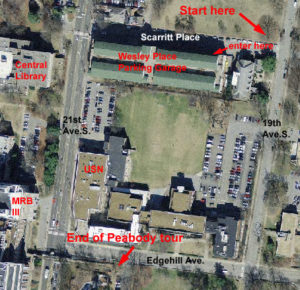Peabody Tree Tour
About the tour
The Peabody tree tour is focused primarily on trees that are native to Middle Tennessee or naturalized, although a few other interesting non-native trees are included. It provides a shorter alternative to the Main Campus tour, which covers similar
trees but is approximately twice as long. The Peabody tour meanders through Magnolia Lawn, promenades down the Esplanade, then winds its way along 21st Ave.S. back to Magnolia Lawn.
How the tour works
The tour is designed to make use of portable devices. An iPad is optimal, although smart phones should also work well. Each tree has its own web page and is connected to the previous and next tree by buttons at the top of the page. In addition to the text description of the tree’s location, there is a map at the bottom of the page showing where the tree is located relative to landmarks on the campus.
If your phone or iPad has GPS, you can use the “Find Me!”
button on the page to locate the tree. When you click on the button, a drop pin will fall on the tree’s location on a map. If you then click on the button to display your location on the map, you can see where you are relative to tree. You should be able to zoom in and make your “blue dot” meet the drop pin as you walk towards the tree. (Because the campus WiFi network covers many outdoor areas, you may be able to take parts of the tour without 3G. However, early version WiFi-only iPads do not have GPS capabilities. The Find Me! button will bring up a map with drop pin, but will not show your location.)
Each tree has a QR code that you can scan to load
the tree’s page into your phone. If a tree on the tour has a physical label, there will be a QR code sticker on the label. This is one way to know that you have located the right tree. It also allows anyone who discovers the
QR code to load the tree’s web page into their portable device.
Where to park
Parking on the Vanderbilt Campus can be challenging because there are few designated visitor spaces. The Visitor Parking page contains information about possible places to park, but for this tour it is recommended that you park in the Wesley Place parking garage because it is near the start of the tour and contains many pay-by-the-hour parking spaces that can be utilized by visitors. There is free parking on the north side of Scarritt Place opposite the garage, but it is for a limited time and is usually filled by mid-morning on weekdays. Do not park in reserved or zone parking without a permit. You will be ticketed and possibly towed.

Starting the tour
The tour starts at the northwest corner of 19th Ave. S. and Scarritt Place. As you exit the Wesley Place garage,
turn right and walk to the end of the block, past the 1101 Building (former Disciples of Christ Historical Society building) on your right. Cross
over to the left side of the street to the first tree, a large tree standing by itself in an open lawn. To start the tour
at the beginning, click on the “Begin” button above.
The Peabody tour ends at the pedestrian bridge that crosses over 21st Ave. S. At that point you can cross over Edgehill Avenue
and travel north along 21st Ave.S. back to the parking garage. Alternatively, you can continue onto the bridge and
start the Main Campus tree tour, which begins at that point.
A second option for starting the tour is by picking a tree from the list below. The tree’s page has a map showing its location.
List of trees on the tour:
Note: since this tour was created, some trees have died or been cut down. They are designated on this list by “R.I.P.” You can still visit their page, but you won’t be able to see the live tree any more.
1: overcup oak (no ID)
2: American basswood 9-4
3: red mulberry 1-314
4: silver maple 1-7 R.I.P.
5: sugar maple 1-591
6: holly 1-251
7: cucumber magnolia 1-845 (R.I.P., cut down in 2022)
8: flowering dogwood 1-635
9: tulip tree 1-126
10: American elm 1-198
11: green ash 1-200
12: white ash 1-734 R.I.P.
13: white basswood 1-415
14: Kentucky coffeetree 1-520 R.I.P.
15: black gum 1-583
16: sugarberry 1-64
17: American beech 1-1273
18: pin oak 1-506
19: white oak 1-38
20: chinkapin oak 1-963
21: swamp chestnut oak 1-420
22: black walnut (no ID)
23: shingle oak 1-418 R.I.P.
24: yellow buckeye 1-81
25: northern red oak 1-508
26: American elm 1-49
27: swamp white oak 1-804 R.I.P.
28: September elm 1-956
29: red hickory 1-714
30: northern hackberry 1-470
31: bur oak 1-476
32: sycamore 1-13 R.I.P.
33: Osage orange 1-71
34: redbud 1-1274
35: yellowwood (no ID)
36: tulip tree (no ID)
37: ginkgo 1-329
